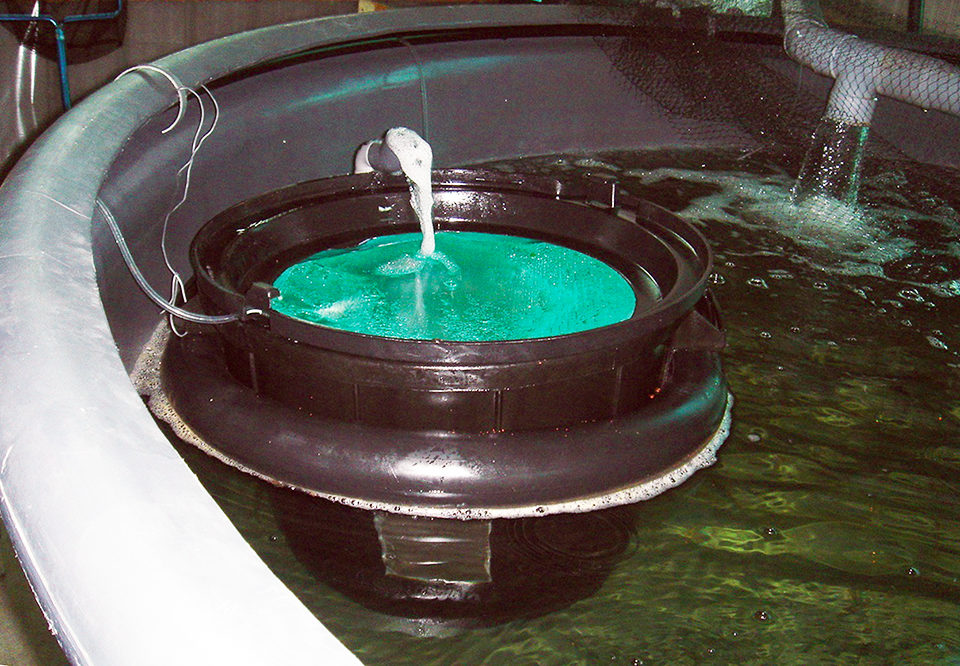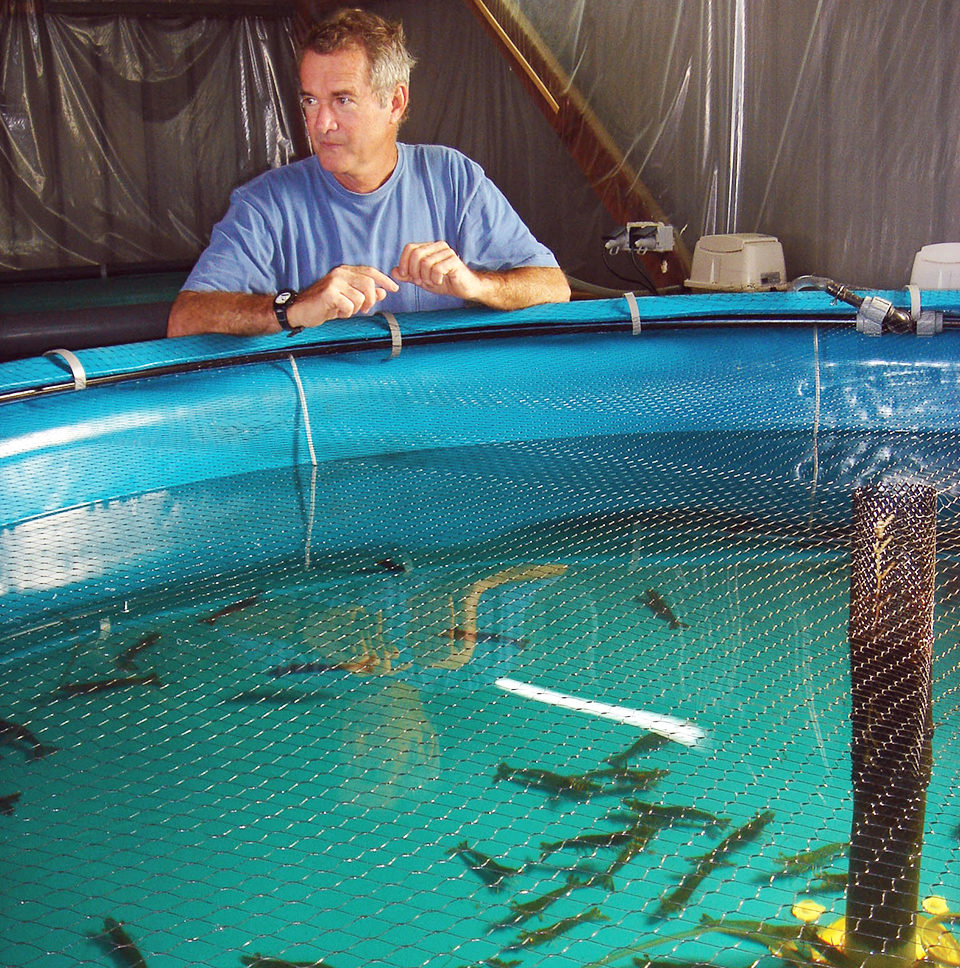Tertiary quarantine can be set up and operated in nearly any location for minimal cost

The New Caledonian shrimp industry is based on the culture of Pacific blue shrimp (Litopenaeus stylirostris). This nonendemic species was first introduced from Panama and Mexico in 1978. In 2002, a study demonstrated the dramatic loss of alleles resulting from the domestication process of the different stocks available in the New Caledonia hatcheries when compared with wild stocks from Ecuador. The shrimp producers decided then that new genetic variability was a good option.
After a risk analysis study was conducted, the introduction of a certified specific pathogen-free (SPF), domesticated blue shrimp line was selected as the best compromise. A stock of L. stylirostris that originated in Ecuador and was domesticated in Hawaii, USA, under strict sanitary conditions was identified as a suitable candidate for introduction in New Caledonia. The association of shrimp farmers of New Caledonia, the State Veterinarian Department and Ifremer combined their financial, zoosanitary, and zootechnical resources and skills to introduce the line.

Operation planning
A tertiary quarantine was considered sufficient to protect the local industry from accidental introduction of any new pathogens. It was decided that the facility should be located inland to avoid possible contamination. Access would be restricted to specific technicians who took preventive measures during the setup of the facility and its operation. The SPF status of the animals would be checked before shipping, upon arrival, and during and after five months of quarantine.
Due to the limited project budget, an existing structure with recirculation of artificial seawater was selected instead of building a new facility. In addition to the use of standard equipment to facilitate maintenance, the rearing setup was to be simple and modular to prevent technical problems and minimize risk.
The plan called for the reception of 1,600 juveniles, a 50 percent survival rate, and final weight of 25 grams at the end of the quarantine period. Based on these factors, a rearing volume of 20 cubic meters was deemed adequate.
Ten months before the scheduled introduction, a preliminary test of a rearing module was successfully carried out using 2.5-cubic-meter tanks set up with biological filters and protein skimmers. A final biomass of 1 kilograms per cubic meter was achieved with 70 percent survival after three months.
Quarantine station
Six months before the shrimp introduction, a warehouse and office were located and outfitted. The 75-square-meter main room was converted into a quarantine culture room with a large foot bath at the entrance. The floor was gently sloped toward a central gutter and sump pump that moved effluent to a tank for chlorination.
A concrete edge was built around the room to contain water in the case of accidental spills. Translucent panels on the walls provided natural illumination. Two closed tanks were located outside the building for water dechlorination. An emergency generator and storage container with artificial sea salt and equipment parts and spares completed the general setup.
Two rearing modules composed of circular 5-cubic-meter polyethylene tanks – each with a biological filter, protein skimmer, automatic feeders, and independent air compressor – were installed. Ultraviolet and 100-omega filtration were centrally positioned for alternative use on each rearing module. A seawater preparation tank module was also set up in the quarantine room.
New shrimp families
Per Ifremer recommendations, animals from 16 different families were imported to optimize the genetic potential of the original stock. Juveniles of each family were tagged before shipment when size permitted. A total of 2,100 juveniles and post-larvae were received in two separate shipments after two days of travel. Mortality during transportation ranged 0 to 80 percent.
After acclimatization, the animals were distributed in tanks according to size and family. Postlarvae were raised in separate floating buckets. During the first two weeks, significant mortalities occurred and then stabilized. Overall survival one week after the second reception was around 50 percent. Mortality appeared to equally affect all families and animal sizes.
Five-month quarantine
During the five-month quarantine period, salinity in the holding tanks was lowered and maintained at 26 to 27 ppt and then raised to an oceanic 35 ppt at the end of the quarantine. Water was recirculated at an exchange rate of around 200 percent per hour. Daily water exchange rates varied 0 to 20 percent based on measurements of several water quality parameters. Calcium carbonate was added as needed to maintain pH around 7.8.
Shrimp were fed high-quality commercial pellets with 55 percent crude protein, distributed by belt feeders. The feed was supplemented every other day with chopped squid.
Mortalities unrelated to molting were regularly observed. Cannibalism accounted for almost half the dead shrimp. A somewhat severe bacterial necrosis of periopods and antenna affected shrimp during the whole quarantine, but without significant effects on animal survival. One major mortality of over 100 individuals was related to a strong thunderstorm. All families were regularly tested and found negative for major shrimp viruses.
After five months of quarantine, 540 shrimp weighing 10 to 35 grams remained to represent the 16 initial families. One-half were transferred to outdoor earthen ponds and grown to reproductive size for five months with 95 percent survival. The other half remained in quarantine as a backup.
Lessons learned
Several lessons were learned during this phase of the project. Importantly, a tertiary quarantine can be set up and operated in nearly any location for minimal cost while still respecting biosecurity and shrimp health. The setup described cost $120,000, including building modifications, equipment, salt, generator and two salaries.
In addition, clearwater culture in biosecure systems with recirculated artificial seawater is feasible with minimum experience. Improvements could be obtained through additional water temperature regulation and continuous ultraviolet treatment to limit bacterial load. Finally, standardization of equipment is essential for daily maintenance.
(Editor’s Note: This article was originally published in the September/October 2007 print edition of the Global Aquaculture Advocate.)
Now that you've finished reading the article ...
… we hope you’ll consider supporting our mission to document the evolution of the global aquaculture industry and share our vast network of contributors’ expansive knowledge every week.
By becoming a Global Seafood Alliance member, you’re ensuring that all of the pre-competitive work we do through member benefits, resources and events can continue. Individual membership costs just $50 a year. GSA individual and corporate members receive complimentary access to a series of GOAL virtual events beginning in April. Join now.
Not a GSA member? Join us.
Authors
-
Jacques Patrois
Ifremer, Département Aquaculture en Calédonie
B.P. 2059 – 98846 Nouméa Cedex, New Caledonia[114,102,46,114,101,109,101,114,102,105,64,115,105,111,114,116,97,112,106]
-
Cyrille Goarant
Ifremer, Département Aquaculture en Calédonie
B.P. 2059 – 98846 Nouméa Cedex, New Caledonia -
Emmanuel Goyard
Ifremer, Département Aquaculture en Calédonie
B.P. 2059 – 98846 Nouméa Cedex, New Caledonia -
Yves Harache
Ifremer, Département Aquaculture en Calédonie
B.P. 2059 – 98846 Nouméa Cedex, New Caledonia -
Pierre Primot
Direction des Affaires Vétérinaires
Alimentaires et Rurales – Nouméa, New Caledonia -
Régis Bador
Union pour la Promotion des Races Aquacoles de Crevettes de Nouvelle
Calédonie, Nouméa, New Caledonia
Tagged With
Related Posts

Health & Welfare
A comprehensive look at the Proficiency Test for farmed shrimp
The University of Arizona Aquaculture Pathology Laboratory has carried out the Proficiency Test (PT) since 2005, with 300-plus diagnostic laboratories participating while improving their capabilities in the diagnosis of several shrimp pathogens.

Responsibility
A look at integrated multi-trophic aquaculture
In integrated multi-trophic aquaculture, farmers combine the cultivation of fed species such as finfish or shrimp with extractive seaweeds, aquatic plants and shellfish and other invertebrates that recapture organic and inorganic particulate nutrients for their growth.

Responsibility
A look at various intensive shrimp farming systems in Asia
The impact of diseases led some Asian shrimp farming countries to develop biofloc and recirculation aquaculture system (RAS) production technologies. Treating incoming water for culture operations and wastewater treatment are biosecurity measures for disease prevention and control.

Intelligence
A motive, and a market, for farmed fish in Mexico
Boasting ample areas for aquaculture and a robust domestic demand for seafood – not to mention its close proximity to the U.S. market – a land of opportunity lies in Mexico. Fish farming is primed to meet its potential south of the border.


